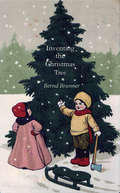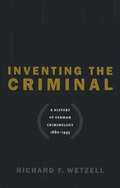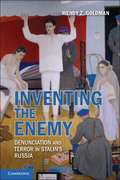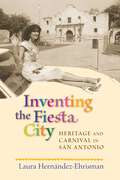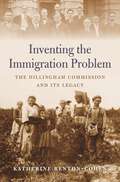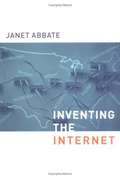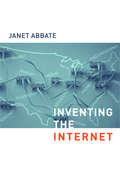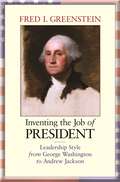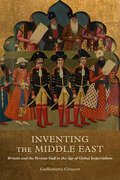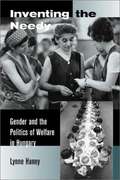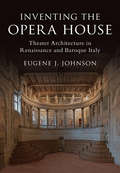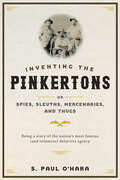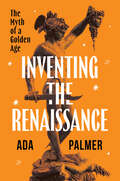- Table View
- List View
Inventing the Built Environment: Planning, Science, and Control in British Architecture (Routledge Research in Architectural History)
by Juliana Yat KeiWhy and how was the term ‘built environment’ first introduced? Inventing the Built Environment retrieves the origin of this ubiquitous term. The articulation of the ‘built environment,’ Kei demonstrates, coincided with the redefinition of education, research, and professional practices in architecture and town planning in 1960s Britain.Concentrating on the half-decade during which the term permeated the architectural and planning professions, this book recalls a time when the ‘built environment’ was conceived as a part of the British government’s effort in national economic planning. Inventing the Built Environment unpacks the proposal for a Research Council for the Built Environment to mobilise architecture and town planning for political economy. How a relatively small group of architects, planners, politicians, and researchers transposed scientific thoughts from biology, economics, and computation into the ‘built environment’ will be considered, too. Kei highlights the assumptions about and classification of the population that were made when inventing the ‘built environment.’ The architectural and biosocial implications of the making and remaking of this architectural-environmental notion, in Britain and beyond, will be revealed through the works of pre-eminent architect-planners including Richard Llewelyn-Davies and William Holford.At a time when environmental concerns again take the front seat of architectural and planning debates, this book offers, for scholars and students, an alternative lens to reflect on the assumptions and bias that can be embedded in our architectural lexicons.
Inventing the Christmas Tree
by Bernd Brunner Benjamin A. SmithA colorfully decorated Christmas tree, lit with twinkling lights, provokes awe and delight. We understand the lighted tree as a central symbol of the Christmas season, but what are the roots of the tradition? Who first thought to bedeck a tree, to bring it inside? How and where did the local activity grow into a widespread tradition, and how has the Christmas tree traveled across time and continents? Bernd Brunner's brief history--enriched by a selection of delightful and unusual historical illustrations--spans many centuries and cultures to illuminate the mysteries of the Christmas tree and its enduring hold on the human imagination. Tracing various European traditions from the Middle Ages forward, Brunner finds that only in the nineteenth century did Christmas trees become common in European family homes. In North America, the imported custom soon fascinated, though some found the tree not quite compatible with a Puritan mindset. Brunner explores how the Christmas tree entered mainstream American culture and how in recent times it has become globally popular. He introduces Jacqueline Kennedy's Nutcracker Tree in the White House, trees used to celebrate the New Year in Turkey, and the world's most expensive Christmas tree, erected in Abu Dhabi. The author also considers the place of the artificial tree and the ecological dimensions of the Christmas tree trade. A book rich with anecdote and insight, Inventing the Christmas Tree will enchant a wide audience.
Inventing the Criminal
by Richard F. WetzellRecent years have witnessed a resurgence of biological research into the causes of crime, but the origins of this kind of research date back to the late nineteenth century. Here, Richard Wetzell presents the first history of German criminology from Imperial Germany through the Weimar Republic to the end of the Third Reich, a period that provided a unique test case for the perils associated with biological explanations of crime.Drawing on a wealth of primary sources from criminological, legal, and psychiatric literature, Wetzell shows that German biomedical research on crime predominated over sociological research and thus contributed to the rise of the eugenics movement and the eventual targeting of criminals for eugenic measures by the Nazi regime. However, he also demonstrates that the development of German criminology was characterized by a constant tension between the criminologists' hereditarian biases and an increasing methodological sophistication that prevented many of them from endorsing the crude genetic determinism and racism that characterized so much of Hitler's regime. As a result, proposals for the sterilization of criminals remained highly controversial during the Nazi years, suggesting that Nazi biological politics left more room for contention than has often been assumed.
Inventing the Egghead
by Aaron LeckliderThroughout the twentieth century, pop songs, magazine articles, plays, posters, and novels in the United States represented intelligence alternately as empowering or threatening. In Inventing the Egghead, cultural historian Aaron Lecklider offers a sharp, entertaining narrative of these sources to reveal how Americans who were not part of the traditional intellectual class negotiated the complicated politics of intelligence within an accelerating mass culture.Central to the book is the concept of brainpower--a term used by Lecklider to capture the ways in which journalists, writers, artists, and others invoked intelligence to embolden the majority of Americans who did not have access to institutions of higher learning. Expressions of brainpower, Lecklider argues, challenged the deeply embedded assumptions in society that intellectual capacity was the province of an educated elite, and that the working class was unreservedly anti-intellectual. Amid changes in work, leisure, and domestic life, brainpower became a means for social transformation in the modern United States. The concept thus provides an exciting vantage point from which to make fresh assessments of ongoing debates over intelligence and access to quality education.Expressions of brainpower in the twentieth century engendered an uncomfortable paradox: they diminished the value of intellectuals (the hapless egghead, for example) while establishing claims to intellectual authority among ordinary women and men, including labor activists, women workers, and African Americans. Reading across historical, literary, and visual media, Lecklider mines popular culture as an arena where the brainpower of ordinary people was commonly invoked and frequently contested.
Inventing the Enemy
by Wendy Z. GoldmanInventing the Enemy uses stories of personal relationships to explore the behaviour of ordinary people during Stalin's terror. Communist Party leaders strongly encouraged ordinary citizens and party members to 'unmask the hidden enemy' and people responded by flooding the secret police and local authorities with accusations. By 1937, every workplace was convulsed by hyper-vigilance, intense suspicion and the hunt for hidden enemies. Spouses, co-workers, friends and relatives disavowed and denounced each other. People confronted hideous dilemmas. Forced to lie to protect loved ones, they struggled to reconcile political imperatives and personal loyalties. Workplaces were turned into snake pits. The strategies that people used to protect themselves - naming names, pre-emptive denunciations, and shifting blame - all helped to spread the terror. Inventing the Enemy, a history of the terror in five Moscow factories, explores personal relationships and individual behaviour within a pervasive political culture of 'enemy hunting'.
Inventing the Feeble Mind: A History of Mental Retardation in the United States
by James W. TrentJames W. Trent uses public documents, private letters, investigative reports, and rare photographs to explore our changing perceptions of mental retardation over the past 150 years. He contends that the economic vulnerability of mentally retarded people (and their families), more than the claims made for their intellectual or social limitations, has determined their institutional treatment.
Inventing the Fiesta City: Heritage and Carnival in San Antonio
by Laura Hernández-EhrismanFiesta San Antonio began in 1891 and through the twentieth century expanded from a single parade to over two hundred events spanning a ten-day period. Laura Hernández-Ehrisman examines Fiesta's development as part of San Antonio's culture of power relations between men and women, Anglos and Mexicanos.In some ways Fiesta resembles hundreds of urban celebrations across the country, but San Antonio offers a unique fusion of Southern, Western, and Mexican cultures that articulates a distinct community identity. From its beginning as a celebration of a new social order in San Antonio controlled by a German and Anglo elite to the citywide spectacle of today, Hernández-Ehrisman traces the connections between Fiesta and the construction of the city's tourist industry and social change in San Antonio.
Inventing the Gothic Corpse: The Thrill Of Human Remains In The Eighteenth-century Novel
by Yael ShapiraInventing the Gothic Corpse shows how a series of bold experiments in eighteenth-century British realist and Gothic fiction transform the dead body from an instructive icon into a thrill device. For centuries, vivid images of the corpse were used to deliver a spiritual or political message; today they appear regularly in Gothic and horror stories as a source of macabre pleasure. Yael Shapira’s book tracks this change at it unfolds in eighteenth-century fiction, from the early novels of Aphra Behn and Daniel Defoe, through the groundbreaking mid-century works of Samuel Richardson, Henry Fielding and Horace Walpole, to the Gothic fictions of Ann Radcliffe, Matthew Lewis, Charlotte Dacre and Minerva Press authors Isabella Kelly and Mrs. Carver. In tracing this long historical arc, Shapira illuminates a hidden side of the history of the novel: the dead body, she shows, helps the fledgling literary form confront its own controversial ability to entertain. Her close scrutiny of fictional corpses across the long eighteenth century reveals how the dead body functions as a test of the novel’s intentions, a chance for novelists to declare their allegiances in the battle between the didactic and the “merely” pleasurable.
Inventing the Immigration Problem: The Dillingham Commission and Its Legacy
by Katherine Benton-CohenIn 1907 the U.S. Congress created a joint commission to investigate what many Americans saw as a national crisis: an unprecedented number of immigrants flowing into the United States. Experts—women and men trained in the new field of social science—fanned out across the country to collect data on these fresh arrivals. The trove of information they amassed shaped how Americans thought about immigrants, themselves, and the nation’s place in the world. Katherine Benton-Cohen argues that the Dillingham Commission’s legacy continues to inform the ways that U.S. policy addresses questions raised by immigration, over a century later. Within a decade of its launch, almost all of the commission’s recommendations—including a literacy test, a quota system based on national origin, the continuation of Asian exclusion, and greater federal oversight of immigration policy—were implemented into law. Inventing the Immigration Problem describes the labyrinthine bureaucracy, broad administrative authority, and quantitative record-keeping that followed in the wake of these regulations. Their implementation marks a final turn away from an immigration policy motivated by executive-branch concerns over foreign policy and toward one dictated by domestic labor politics. The Dillingham Commission—which remains the largest immigration study ever conducted in the United States—reflects its particular moment in time when mass immigration, the birth of modern social science, and an aggressive foreign policy fostered a newly robust and optimistic notion of federal power. Its quintessentially Progressive formulation of America’s immigration problem, and its recommendations, endure today in almost every component of immigration policy, control, and enforcement.
Inventing the Individual: The Origins of Western Liberalism
by Larry SiedentopHere, in a grand narrative spanning 1,800 years of European history, a distinguished political philosopher firmly rejects Western liberalism's usual account of itself: its emergence in opposition to religion in the early modern era. Larry Siedentop argues instead that liberal thought is, in its underlying assumptions, the offspring of the Church.
Inventing the Internet
by Janet AbbateSince the late 1960s the Internet has grown from a single experimental network serving a dozen sites in the United States to a network of networks linking millions of computers worldwide. In Inventing the Internet, Janet Abbate recounts the key players and technologies that allowed the Internet to develop; but her main focus is always on the social and cultural factors that influenced the Internets design and use. The story she unfolds is an often twisting tale of collaboration and conflict among a remarkable variety of players, including government and military agencies, computer scientists in academia and industry, graduate students, telecommunications companies, standards organizations, and network users. The story starts with the early networking breakthroughs formulated in Cold War think tanks and realized in the Defense Department's creation of the ARPANET. It ends with the emergence of the Internet and its rapid and seemingly chaotic growth. Abbate looks at how academic and military influences and attitudes shaped both networks; how the usual lines between producer and user of a technology were crossed with interesting and unique results; and how later users invented their own very successful applications, such as electronic mail and the World Wide Web. She concludes that such applications continue the trend of decentralized, user-driven development that has characterized the Internet's entire history and that the key to the Internet's success has been a commitment to flexibility and diversity, both in technical design and in organizational culture.
Inventing the Internet (Inside Technology)
by Janet AbbateJanet Abbate recounts the key players and technologies that allowed the Internet to develop; but her main focus is always on the social and cultural factors that influenced the Internet's design and use.Since the late 1960s the Internet has grown from a single experimental network serving a dozen sites in the United States to a network of networks linking millions of computers worldwide. In Inventing the Internet, Janet Abbate recounts the key players and technologies that allowed the Internet to develop; but her main focus is always on the social and cultural factors that influenced the Internets design and use. The story she unfolds is an often twisting tale of collaboration and conflict among a remarkable variety of players, including government and military agencies, computer scientists in academia and industry, graduate students, telecommunications companies, standards organizations, and network users.The story starts with the early networking breakthroughs formulated in Cold War think tanks and realized in the Defense Department's creation of the ARPANET. It ends with the emergence of the Internet and its rapid and seemingly chaotic growth. Abbate looks at how academic and military influences and attitudes shaped both networks; how the usual lines between producer and user of a technology were crossed with interesting and unique results; and how later users invented their own very successful applications, such as electronic mail and the World Wide Web. She concludes that such applications continue the trend of decentralized, user-driven development that has characterized the Internet's entire history and that the key to the Internet's success has been a commitment to flexibility and diversity, both in technical design and in organizational culture.
Inventing the It Girl: How Elinor Glyn Created The Modern Romance And Conquered Early Hollywood
by Hilary A. HallettA Publishers Weekly Summer Reads Selection The modern romance novel is elevated to a subject of serious study in this addictively readable biography of pioneering celebrity author Elinor Glyn. Unlike typical romances, which end with wedding bells, Elinor Glyn’s (1864–1943) story really began after her marriage up the social ladder and into the English gentry class in 1892. Born in the Channel Islands, Elinor Sutherland, like most Victorian women, aspired only to a good match. But when her husband, Clayton Glyn, gambled their fortune away, she turned to her pen and boldly challenged the era’s sexually straightjacketed literary code with her notorious succes de scandale, Three Weeks (1907). An intensely erotic tale about an unhappily married woman’s sexual education of her young lover, the novel got Glyn banished from high society but went on to sell millions, revealing a deep yearning for a fuller account of sexual passion than permitted by the British aristocracy or the Anglo-American literary establishment. In elegant prose, Hilary A. Hallett traces Glyn’s meteoric rise from a depressed society darling to a world-renowned celebrity author who consorted with world leaders from St. Petersburg to Cairo to New York. After reporting from the trenches during World War I, the author was lured by American movie producers from Paris to Los Angeles for her remarkable third act. Weaving together years of deep archival research, Hallett movingly conveys how Glyn, more than any other individual during the Roaring Twenties, crafted early Hollywood’s glamorous romantic aesthetic. She taught the screen’s greatest leading men to make love in ways that set audiences aflame, and coined the term “It Girl,” which turned actress Clara Bow into the symbol of the first sexual revolution. With Inventing the It Girl, Hallett has done nothing less than elevate the origins of the modern romance genre to a subject of serious study. In doing so, she has also reclaimed the enormous influence of one of Anglo-America’s most significant cultural tastemakers while revealing Glyn’s life to have been as sensational as any of the characters she created on the page or screen. The result is a groundbreaking portrait of a courageous icon of independence who encouraged future generations to chase their desires wherever they might lead.
Inventing the Job of President: Leadership Style from George Washington to Andrew Jackson
by Fred I. GreensteinHow the early presidents shaped America's highest officeFrom George Washington's decision to buy time for the new nation by signing the less-than-ideal Jay Treaty with Great Britain in 1795 to George W. Bush's order of a military intervention in Iraq in 2003, the matter of who is president of the United States is of the utmost importance. In this book, Fred Greenstein examines the leadership styles of the earliest presidents, men who served at a time when it was by no means certain that the American experiment in free government would succeed.In his groundbreaking book The Presidential Difference, Greenstein evaluated the personal strengths and weaknesses of the modern presidents since Franklin D. Roosevelt. Here, he takes us back to the very founding of the republic to apply the same yardsticks to the first seven presidents from Washington to Andrew Jackson, giving his no-nonsense assessment of the qualities that did and did not serve them well in office. For each president, Greenstein provides a concise history of his life and presidency, and evaluates him in the areas of public communication, organizational capacity, political skill, policy vision, cognitive style, and emotional intelligence. Washington, for example, used his organizational prowess—honed as a military commander and plantation owner—to lead an orderly administration. In contrast, John Adams was erudite but emotionally volatile, and his presidency was an organizational disaster.Inventing the Job of President explains how these early presidents and their successors shaped the American presidency we know today and helped the new republic prosper despite profound challenges at home and abroad.
Inventing the Mathematician: Gender, Race, and Our Cultural Understanding of Mathematics
by Sara N. HottingerWhere and how do we, as a culture, get our ideas about mathematics and about who can engage with mathematical knowledge? Sara N. Hottinger uses a cultural studies approach to address how our ideas about mathematics shape our individual and cultural relationship to the field. She considers four locations in which representations of mathematics contribute to our cultural understanding of mathematics: mathematics textbooks, the history of mathematics, portraits of mathematicians, and the field of ethnomathematics. Hottinger examines how these discourses shape mathematical subjectivity by limiting the way some groups—including women and people of color—are able to see themselves as practitioners of math. Inventing the Mathematician provides a blueprint for how to engage in a deconstructive project, revealing the limited and problematic nature of the normative construction of mathematical subjectivity.
Inventing the Middle East: Britain and the Persian Gulf in the Age of Global Imperialism
by Guillemette CrouzetThe “Middle East” has long been an indispensable and ubiquitous term in discussing world affairs, yet its history remains curiously underexplored. Few question the origin of the term or the boundaries of the region, commonly understood to have emerged in the twentieth century after World War I.Guillemette Crouzet offers a new account in Inventing the Middle East. The book traces the idea of the Middle East to a century-long British imperial zenith in the Indian subcontinent and its violent overspill into the Persian Gulf and its hinterlands. Encroachment into the Gulf region began under the expansionist East India Company. It was catalyzed by Napoleon’s invasion of Egypt and heightened by gunboat attacks conducted in the name of pacifying Arab “pirates.” Throughout the 1800s the British secured this crucial geopolitical arena, transforming it into both a crossroads of land and sea and a borderland guarding British India’s western flank. Establishing this informal imperial system involved a triangle of actors in London, the subcontinent, and the Gulf region itself. By the nineteenth century’s end, amid renewed waves of inter-imperial competition, this nexus of British interests and narratives in the Gulf region would occasion the appearance of a new name: the Middle East.Charting the spatial, political, and cultural emergence of the Middle East, Inventing the Middle East reveals the deep roots of the twentieth century’s geographic upheavals.
Inventing the Modern Yiddish Stage: Essays in Drama, Performance, and Show Business
by Barbara Henry Joel BerkowitzCollects leading scholars' insight on the plays, production, music, audiences, and political and aesthetic concerns of modern Yiddish theater.
Inventing the Needy: Gender and the Politics of Welfare in Hungary
by Lynne A. HaneyThis ambitious, fluid, and engaging book explains the political and social transformation of the Hungarian state from 1948 to the present. Haney reconceptualizes how we might understand the momentous changes of 1989, resisting the usual categories of the socialist past and the capitalist present.
Inventing the Opera House: Theater Architecture In Renaissance And Baroque Italy
by Eugene J. JohnsonIn this book, Eugene J. Johnson traces the invention of the opera house, a building type of world wide importance. <P><P>Italy laid the foundation theater buildings in the West, in architectural spaces invented for the commedia dell'arte in the sixteenth century, and theaters built to present the new art form of opera in the seventeenth. Rulers lavished enormous funds on these structures. Often they were among the most expensive artistic undertakings of a given prince. They were part of an upsurge of theatrical invention in the performing arts. At the same time, the productions that took place within the opera house could threaten the social order, to the point where rulers would raze them. Johnson reconstructs the history of the opera house by bringing together evidence from a variety of disciplines, including music, art, theatre, and politics. Writing in an engaging manner, he sets the history of the opera house within its broader early modern social context.<P> This is the only book, since the 1930s, to cover this subject, and the only English language one to ever be produced.<P> Sets the subject into a broad context of the arts, politics, and social history of the period.<P> The book aims to reach both specialists and the general reader, making it appealing to those who know the field well and those who do not care to plow through scholarly jargon.
Inventing the PC
by Zbigniew StachniakInventing the PC details the invention and design of the MCM/70 computer and the prolonged struggle to bring it to market. Zbigniew Stachniak offers an insider's view of events on the front lines of pioneering work on personal computers. He shows what information and options PC pioneers had, how well they understood what they were doing, and how that understanding - or lack thereof - shaped both their engineering ingenuity and the indecisiveness and over-reaching ambition that would ultimately turn a very promising venture into a missed opportunity. Providing comprehensive historical background and rich photographic documentation, Inventing the PC tells the story of a Canadian company on the cutting-edge of the information age.
Inventing the PC: The MCM/70 Story
by Zbigniew StachniakInventing the PC details the invention and design of the MCM/70 computer and the prolonged struggle to bring it to market. Zbigniew Stachniak offers an insider's view of events on the front lines of pioneering work on personal computers. He shows what information and options PC pioneers had, how well they understood what they were doing, and how that understanding - or lack thereof - shaped both their engineering ingenuity and the indecisiveness and over-reaching ambition that would ultimately turn a very promising venture into a missed opportunity. Providing comprehensive historical background and rich photographic documentation, Inventing the PC tells the story of a Canadian company on the cutting-edge of the information age.
Inventing the People: The Rise of Popular Sovereignty in England and America
by Edmund S. Morgan"The best explanation that I have seen for our distinctive combination of faith, hope and naiveté concerning the governmental process." --Michael Kamman, Washington Post This book makes the provocative case here that America has remained politically stable because the Founding Fathers invented the idea of the American people and used it to impose a government on the new nation. His landmark analysis shows how the notion of popular sovereignty--the unexpected offspring of an older, equally fictional notion, the "divine right of kings"--has worked in our history and remains a political force today.
Inventing the People: The Rise of Popular Sovereignty in England and America
by Edmund Sears MorganThis book makes the provocative case here that America has remained politically stable because the Founding Fathers invented the idea of the American people and used it to impose a government on the new nation. His landmark analysis shows how the notion of popular sovereignty the unexpected offspring of an older, equally fictional notion, the "divine right of kings" has worked in our history and remains a political force today.
Inventing the Pinkertons; or, Spies, Sleuths, Mercenaries, and Thugs: Being a story of the nation’s most famous (and infamous) detective agency
by S. Paul O'HaraThe fascinating story of the most notorious detective agency in US history.Between 1865 and 1937, Pinkerton’s National Detective Agency was at the center of countless conflicts between capital and labor, bandits and railroads, and strikers and state power. Some believed that the detectives were protecting society from dangerous criminal conspiracies; others thought that armed Pinkertons were capital’s tool to crush worker dissent. Yet the image of the Pinkerton detective also inspired romantic and sensationalist novels, reflected shifting ideals of Victorian manhood, and embodied a particular kind of rough frontier justice. Inventing the Pinkertons examines the evolution of the agency as a pivotal institution in the cultural history of American monopoly capitalism. Historian S. Paul O’Hara intertwines political, social, and cultural history to reveal how Scottish-born founder Allan Pinkerton insinuated his way to power and influence as a purveyor of valuable (and often wildly wrong) intelligence in the Union cause. During Reconstruction, Pinkerton turned his agents into icons of law and order in the Wild West. Finally, he transformed his firm into a for-rent private army in the war of industry against labor. Having begun life as peddlers of information and guardians of mail bags, the Pinkertons became armed mercenaries, protecting scabs and corporate property from angry strikers.O’Hara argues that American capitalists used the Pinkertons to enforce new structures of economic and political order. Yet the infamy of the Pinkerton agent also gave critics and working communities a villain against which to frame their resistance to the new industrial order. Ultimately, Inventing the Pinkertons is a gripping look at how the histories of American capitalism, industrial folklore, and the nation-state converged.
Inventing the Renaissance: The Myth of a Golden Age
by Ada PalmerAn irreverent new take on the Renaissance, which reveals it as anything but Europe’s golden age. From the darkness of a plagued and war-torn Middle Ages, the Renaissance (we’re told) heralds the dawning of a new world—a halcyon age of art, prosperity, and rebirth. Hogwash! or so says award-winning novelist and historian Ada Palmer. In Inventing the Renaissance, Palmer turns her witty and irreverent eye on the fantasies we’ve told ourselves about Europe’s not-so-golden age, myths she sets right with sharp clarity. Palmer’s Renaissance is altogether desperate. Troubled by centuries of conflict, she argues, Europe looked to a long-lost Roman Empire (even its education practices) to save them from unending war. Later historians met their own political challenges with a similarly nostalgic vision, only now they looked to the Renaissance and told a partial story. To right this wrong, Palmer offers fifteen provocative portraits of Renaissance men and women (some famous, some obscure) whose lives reveal a far more diverse, fragile, and wild Renaissance than its glowing reputation suggests.

